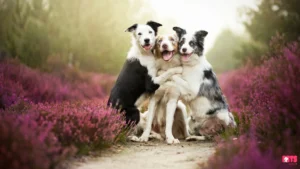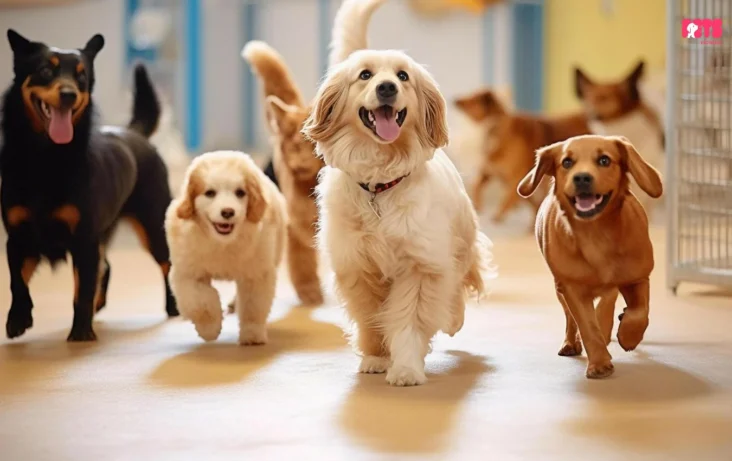Dogs have earned the title of “man’s best friend” because of their loyalty, love, and lively characters. The possibility of a “Happy Dog” infers a picture of a tail-swaying, playful, and fulfilled pet. Yet, what does it take to guarantee that your dog’s remaining parts are upbeat and satisfied?
In this article, we will investigate the parts that add to a happy dog, addressing variables, for example, legitimate consideration, ways of behaving, and the one of a kind qualities that make puppies such treasured partners.
Understanding Dogs Happiness:

A happy dog participates in a good overall arrangement of active work, mental awareness, and consideration close to home. It’s not just about keeping your pup engaged or taken care of; it’s tied in with fostering the responsibility of trust, love, and understanding. A female dog exhibits a positive demeanor, genuine happiness, and a general sense of euphoria.
There are a few important points to consider when assessing and improving your dog’s satisfaction:
- Physical Health: A Dog Happiness is completely linked to its health. A proper eating routine, exercise, and quilted check-ups with the vet can contribute incredibly to a pup’s well-being.
- Mental Stimulation: Dogs need mental stimulation to be happy like most people. Intuitive toys, puzzles, and preparation methods are great ways to keep the dog’s mind active.
- Socialization: Happy Dog puppies are inherently friendly animals. Investing energy with their owners, cooperating with different dogs, and living in an active environment can create a good sense of security and happiness for them.
- Routine and Training: Stable schedules help pups with a solid sense of reassurance. Proper grooming reduces stress and social problems, encouraging a more relaxed and happy dog.
- Love and Attention: Happy Dog, The most important component is that a dog thrives on love, affection, and consideration from its owner.
Physical Signs Of A Happy Dog:

A happy puppy displays specific behaviors and real signs that can help owners survey their deeper state:
- Wagging Tail: One of the clearest signs of happiness is tail wagging. However, it’s critical to note that different types of tail swaying can mean various things, so it’s important to focus on the rest of the dog’s nonverbal communication.
- Relaxed Ears and Face: A happy dog often has a delicate, relaxed expression. Their ears will be in a neutral position, and their mouth may be slightly open than normal.
- Playfulness: Canines who are happy often need to play. They may bring you toys or show a work of art “play bow,” where their front legs are extended, and their back is in the air.
- Good Appetite: In many cases, A sense of hunger is a reasonable sign of a puppy’s physical and household well-being.
- Calm and Relaxed: Although pups can be fiery, a truly happy dog will also have snapshots of smoothness and comfort, where they feel secure enough to relax or lounge around.
Factors That Contribute To A Happy Dog:

- Proper Diet
Diet plays a vital role in a dog’s happiness. Taking care of your puppy with the right supplements works to their actual well-being as well as the prosperity of their home. A balanced meal plan should include proteins, starch, solid fats and basic nutrients. puppies who maintain a nutritious eating routine are generally more active, energetic, and genuinely happy.
- Exercise
Exercise is essential for both the physical and psychological well-being of dogs. Traditional walks, breaks, and outdoor exercises help prevent excessive energy by consuming off abundance of energy use and fatigue, which can signal destructive behavior patterns. A very much practised pup is bound to be quiet, satisfied, and less inclined to nervousness.
- Mental Stimulation
Happy Dogs are smart creatures, and like most people, they need to keep their psyches active. Toys, puzzles, and exercises like fetch, back and forth, or finding a stowaway help draw a dog intellectually, increasing their general happiness.
- Training
Grooming isn’t just about showing off to your dog orders—it’s about building serious areas of strength with them. A well-groomed dog has a good sense of trust and confidence, which adds to their contentment. Instructional courses likewise provide mental stimulation and motivational feedback, which help reduce stress and promote a calm, cheerful mood.
- Socialization
Dog are typically pack creatures and that means they thrive in friendly situations. Standard communication with different pups and individuals helps foster their interactive abilities and forestalls sensations of segregation or tension. Puppies that are all around mingled are bound to display blissful and positive ways of behaving.
Table: Dog Breeds And Their Happiness Factors:

The following is a table that describes the different types of dogs, their actual qualities, behavioural characteristics, and life expectancy. Each breed has special needs and qualities that influence how they experience happiness.
| Breed | Color Variations | Behavior Traits | Specifications | Lifespan |
| Golden Retriever |
Golden, cream, dark gold |
Friendly, loyal, playful |
Requires regular exercise, loves water |
10-12 years |
| Labrador Retriever |
Yellow, chocolate, black |
Energetic, intelligent, affectionate |
High energy, great for families |
10-14 years |
| Beagle |
Tri-color, lemon, red |
Curious, merry, friendly |
Moderate exercise; loves tracking odours |
12-15 years |
| Poodle |
White, black, apricot, cream |
Intelligent, active, eager to please |
Needs mental stimulation, hypoallergenic |
12-15 years |
| Bulldog |
Brindle, white, fawn |
Calm, courageous, affectionate |
Low-energy, sensitive to heat |
8-10 years |
| German Shepherd |
Black, brown, sable, and white |
Loyal, confident, intelligent |
High-energy, great for working roles |
9-13 years |
| Shih Tzu |
Black, white, gold, red |
Friendly, alert, playful |
Low-energy, ideal for apartment living |
10-16 years |
| Chihuahua |
Black, fawn, chocolate |
Lively, confident, alert |
Requires minimal exercise, small breed |
12-20 years |
| Dachshund |
Red, black, tan |
Curious, brave, lively |
Moderate exercise, prone to back problems |
12-16 years |
| Siberian Husky |
Tri-color, lemon, red |
Energetic and friendly |
High-energy, loves cold weather |
12-15 years |
Conclusion:
A happy dog is the result of careful consideration of their physical, emotional, and mental needs. Whether through proper eating routine, customised activity, grooming, or simple walking, puppy owners can guarantee their pets lead a happy contented life. Understanding your canine’s special character and needs is the key to maintaining their happiness. As a result, you’ll be rewarded with the unqualified love and friendship that a canine can offer.
FAQs
How can I explain if my dog is happy?
A happy dog gives cues such as wagging their tail, flopping ears, being excited, and generally having a quiet disposition.
What should I do to make my dog happier?
Ensure your dog has a proper eating routine, regular exercise, mental stimulation, and socialization. Preparation and quality time with you also improve their happiness.
Is my dog’s happiness tied to its physical health?
Indeed, a solid pup is bound to be satisfied. Regular vet check-ups, a nutritious eating routine, and legitimate activities all add to your dog’s well-being.
Can dogs get bored?
Absolutely! A puppy needs mental stimulation to be happy. Giving them intuitive toys and exercises helps reduce exhaustion.

